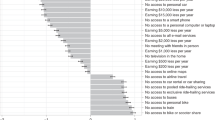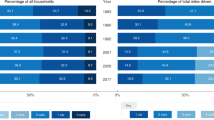Abstract
For the market share of plug-in electric vehicles (PEVs) to continue to grow and reach 100% of new vehicle sales, adopters of the technology, who initially buy PEVs, will need to continue choosing them in subsequent purchases. Although much research has focused on the reasons for, and barriers to, initial PEV purchase, less has been devoted to the reasons for discontinuance—abandoning a new technology after first purchasing it. Here, on the basis of results from five questionnaire surveys, we find that PEV discontinuance in California occurs at a rate of 20% for plug-in hybrid electric vehicle owners and 18% for battery electric vehicle owners. We show that discontinuance is related to dissatisfaction with the convenience of charging, having other vehicles in the household that are less efficient, not having level 2 (240-volt) charging at home, having fewer household vehicles and not being male.
This is a preview of subscription content, access via your institution
Access options
Access Nature and 54 other Nature Portfolio journals
Get Nature+, our best-value online-access subscription
$29.99 / 30 days
cancel any time
Subscribe to this journal
Receive 12 digital issues and online access to articles
$119.00 per year
only $9.92 per issue
Buy this article
- Purchase on Springer Link
- Instant access to full article PDF
Prices may be subject to local taxes which are calculated during checkout




Similar content being viewed by others
Data availability
The questionnaire survey data used in this study can be obtained from The Dryad Digital Repository: https://doi.org/10.25338/B8WS6R. More information on the data, the variables included, and a description of each variable are available in DRYAD.
References
Plötz, P., Axsen, J., Funke, S. A. & Gnann, T. Designing car bans for sustainable transportation. Nat. Sustain. 2, 534–536 (2019).
Rogers, E. M. Diffusion of Innovations 5th edn (Free Press, 2003).
US electric vehicle loyalty and volumes reach record highs, according to IHS Markit. IHS Markit (15 April 2019); https://news.ihsmarkit.com/prviewer/release_only/slug/automotive-us-electric-vehicle-loyalty-and-volumes-reach-record-highs-according-ihs-ma
Egbue, O. & Long, S. Barriers to widespread adoption of electric vehicles: an analysis of consumer attitudes and perceptions. Energy Pol. 48, 717–729 (2012).
Schneidereit, T., Franke, T., Günther, M. & Krems, J. F. Does range matter? Exploring perceptions of electric vehicles with and without a range extender among potential early adopters in Germany. Energy Res Soc. Sci. 8, 198–206 (2015).
Kurani, K. S., Turrentine, T. & Sperling, D. Demand for electric vehicles in hybrid households: an exploratory analysis. Transp. Pol. 1, 244–256 (1994).
Hidrue, M., Parsons, G., Kempton, W. & Gardner, M. Willingness to pay for electric vehicles and their attributes. Resour. Energy Econ. 33, 686–705 (2011).
Graham-Rowe, E. et al. Mainstream consumers driving plug-in battery-electric and plug-in hybrid electric cars: a qualitative analysis of responses and evaluations. Transp. Res. A 46, 140–153 (2012).
Helveston, J. P. et al. Will subsidies drive electric vehicle adoption? Measuring consumer preferences in the U.S. and China. Transp. Res. A 73, 96–112 (2015).
Axsen, J. & Kurani, K. S. Hybrid, plug-in hybrid, or electric—what do car buyers want? Energy Pol. 61, 532–543 (2013).
Plötz, P. & Gnann, T. Who Should Buy Electric Vehicles?—The Potential Early Adopter from an Economical Perspective 1073–1080 (ECEEE, 2011).
Skippon, S. & Garwood, M. Responses to battery electric vehicles: UK consumer attitudes and attributions of symbolic meaning following direct experience to reduce psychological distance. Transp. Res. D 16, 525–531 (2011).
Adamson, K. An examination of consumer demand in the secondary niche market for fuel cell vehicles in Europe. Int J. Hydrog. Energy 28, 771–780 (2003).
Westin, K., Jansson, J. & Nordlund, A. The importance of socio-demographic characteristics, geographic setting, and attitudes for adoption of electric vehicles in Sweden. Travel Behav. Soc. 13, 118–127 (2018).
Figenbaum, E. & Kolbenstvedt, M. Learning from Norwegian Battery Electric and Plug-in Hybrid Vehicle Users (Institute of Transport Economics Norwegian Centre for Transport Research, 2016).
Hardman, S., Shiu, E. & Steinberger-Wilckens, R. Comparing high-end and low-end early adopters of battery electric vehicles. Transp. Res. A 88, 40–57 2016).
Hardman, S. & Tal, G. Exploring the decision to adopt a high-end battery electric vehicle: the role of financial and non-financial motivations. Transp. Res. Rec. J. Transp. Res. Board. https://doi.org/10.3141/2572-03 (2016).
Axsen, J., Cairns, J., Dusyk, N. & Goldberg, S. What drives the Pioneers? Applying lifestyle theory to early electric vehicle buyers in Canada. Energy Res. Soc. Sci. 44, 17–30 (2018).
Axsen, J., Bailey, J. & Andrea, M. Preference and lifestyle heterogeneity among potential plug-in electric vehicle buyers. Energy Econ. 50, 190–201 (2015).
Gnann, T., Plötz, P., Funke, S. & Wietschel, M. What is the market potential of plug-in electric vehicles as commercial passenger cars? A case study from Germany. Transp. Res. D 37, 171–187 (2015).
Carley, S., Krause, R. M., Lane, B. W. & Graham, J. D. Intent to purchase a plug-in electric vehicle: a survey of early impressions in large US cites. Transp. Res. D 18, 39–45 (2013).
Schuitema, G., Anable, J., Skippon, S. & Kinnear, N. The role of instrumental, hedonic and symbolic attributes in the intention to adopt electric vehicles. Transp. Res. A 48, 39–49 (2013).
White, L. V. & Sintov, N. D. You are what you drive: environmentalist and social innovator symbolism drives electric vehicle adoption intentions. Transp. Res. A 99, 94–113 (2017).
Bunch, D. S., Bradley, M., Golob, T. F., Kitamura, R. & Occhiuzzo, G. P. Demand for clean-fuel vehicles in California: a discrete-choice stated preference pilot project. Transp. Res. A 27, 237–253 (1993).
Higueras-Castillo, E., Molinillo, S., Coca-Stefaniak, J. A. & Li, F. Perceived value and customer adoption of electric and hybrid vehicles. Sustainability 11, 4956 (2019).
Choi, D. & Johnson, K. K. P. Influences of environmental and hedonic motivations on intention to purchase green products: an extension of the theory of planned behavior. Sustain Prod. Consum. 18, 145–155 (2019).
Huang, X. & Ge, J. Electric vehicle development in Beijing: an analysis of consumer purchase intention. J. Clean. Prod. 216, 361–372 (2019).
Liu, Y., Ouyang, Z. & Cheng, P. Predicting consumers’ adoption of electric vehicles during the city smog crisis: an application of the protective action decision model. J. Environ. Psychol. 64, 30–38 (2019).
Rezvani, Z., Jansson, J. & Bodin, J. Advances in consumer electric vehicle adoption research: a review and research agenda. Transp. Res. D 34, 122–136 (2015).
Hardman, S. & Tal, G. Exploring the decision to adopt a high-end battery electric vehicle role of financial and nonfinancial motivations. Transp. Res. Rec. J. Transp. Res. Board https://doi.org/10.3141/2572-03 (2016).
Lane, B. et al. Beyond Early Adopters of Plug-in Electric Vehicles? Evidence from Fleet and Household Users in Indianapolis 1–18 (Transportation Research Board, 2014).
Caperello, N., TyreeHageman, J. & Davies, J. I Am Not an Environmental Wacko! Getting from Early Plug-in Vehicle Owners to Potential Later Buyers Working Paper – UCD-ITS-WP-14-05 (Institute of Transportation Studies, 2015).
Egbue, O. & Long, S. Barriers to widespread adoption of electric vehicles: an analysis of consumer attitudes and perceptions. Energy Pol. 48, 717–729 (2012).
Hardman, S., Chandan, A., Tal, G. & Turrentine, T. The effectiveness of financial purchase incentives for battery electric vehicles—a review of the evidence. Renew. Sustain. Energy Rev. 80, 1100–1111 (2017).
Hardman, S. Understanding the impact of reoccurring and non-financial incentives on plug-in electric vehicle adoption—a review. Transp. Res. A 119, 1–14 (2019).
Jabbari, P., Chernicoff, W. & Mackenzie, D. Analysis of electric vehicle purchaser satisfaction and rejection reasons. Transp. Res. Rec. J. Transp. Res. Board https://doi.org/10.3141/2628-12 (2017).
Adepetu, A. & Keshav, S. The relative importance of price and driving range on electric vehicle adoption: Los Angeles case study. Transportation 44, 353–373 (2017).
She, Z., Sun, Q., Ma, J. & Xie, B. What are the barriers to widespread adoption of battery electric vehicles? A survey of public perception in Tianjin, China. Transp. Pol. 56, 29–40 (2017).
Vassileva, I. & Campillo, J. Adoption barriers for electric vehicles: experiences from early adopters in Sweden. Energy 120, 632–641 (2017).
Franke, T., Neumann, I., Bühler, F., Cocron, P. & Krems, J. F. Experiencing range in an electric vehicle: understanding psychological barriers. Appl. Psychol. 61, 368–391 (2012).
Dumortier, J. et al. Effects of providing total cost of ownership information on consumers’ intent to purchase a hybrid or plug-in electric vehicle. Transp. Res. A 72, 71–86 (2015).
Kim, S., Lee, J. & Lee, C. Does driving range of electric vehicles influence electric vehicle adoption? Sustainability 9, 1783 (2017).
Berkeley, N., Jarvis, D. & Jones, A. Analysing the take up of battery electric vehicles: an investigation of barriers amongst drivers in the UK. Transp. Res. D. 63, 466–481 (2018).
Kurani, K. S., Caperello, N. & TyreeHageman, J. Are we Hardwiring Gender Differences into the Market for Plug-in Electric Vehicles (Institute of Transportation Studies, 2018).
Jenn, A., Lee, J. H., Hardman, S. & Tal, G. An in-depth examination of electric vehicle incentives: consumer heterogeneity and changing response over time. Transp. Res. A 132, 97–109 (2020).
Lee, J. H., Hardman, S. & Tal, G. Who is buying electric vehicles in California? Characterising early adopter heterogeneity and forecasting market diffusion. Energy Res. Soc. Sci. 55, 218–226 (2019).
Chakraborty, D., Bunch, D. S., Lee, J. H. & Tal, G. Demand drivers for charging infrastructure-charging behavior of plug-in electric vehicle commuters. Transp. Res. D 76, 255–272 (2019).
Acknowledgements
We thank M. Favetti for programming and supporting the development of the questionnaire survey used in this study, S. Karten for proofreading and editing the paper before submission. The analysis conducted in this study was funded by a grant from the National Center for Sustainable Transportation (NCST), supported by USDOT through the University Transportation Centers programme (USDOT grant no. 69A3551747114). The questionnaire surveys were funded by the California Air Resources Board (CARB). We thank NCST, USDOT and CARB for their support of this project.
Author information
Authors and Affiliations
Contributions
S.H. and G.T. were responsible for study design and conception, performed data collection, drafted and revised the manuscript, and approved the final version of the manuscript. S.H. performed the analysis.
Corresponding author
Ethics declarations
Competing interests
The authors declare no competing interests.
Additional information
Peer review information Nature Energy thanks Stefan Mabit and the other, anonymous, reviewer(s) for their contribution to the peer review of this work.
Publisher’s note Springer Nature remains neutral with regard to jurisdictional claims in published maps and institutional affiliations.
Supplementary information
Supplementary Information
Supplementary Tables 1–6 and Fig. 1.
Rights and permissions
About this article
Cite this article
Hardman, S., Tal, G. Understanding discontinuance among California’s electric vehicle owners. Nat Energy 6, 538–545 (2021). https://doi.org/10.1038/s41560-021-00814-9
Received:
Accepted:
Published:
Issue Date:
DOI: https://doi.org/10.1038/s41560-021-00814-9
This article is cited by
-
Ownership of battery electric vehicles is uneven in Norwegian households
Communications Earth & Environment (2024)
-
Hidden delays of climate mitigation benefits in the race for electric vehicle deployment
Nature Communications (2023)
-
The adoption and disadoption of electric vehicles by innovators
Marketing Letters (2023)
-
Resilience of urban public electric vehicle charging infrastructure to flooding
Nature Communications (2022)
-
Charging infrastructure access and operation to reduce the grid impacts of deep electric vehicle adoption
Nature Energy (2022)



